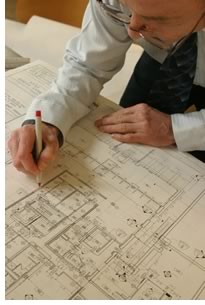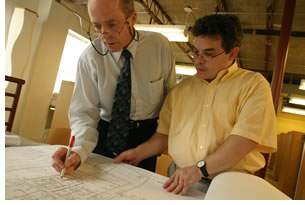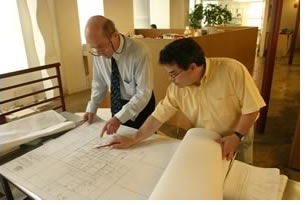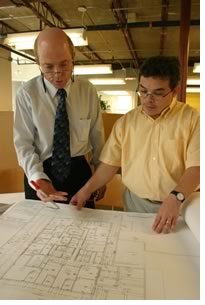

08/2005
Reprinted from Guidelines for Improving Practice
published by Victor O. Schinnerer & Co.
 Control over the ownership
and use of intellectual property is being increasingly challenged by
the accelerating pace of digital practice. Projects on which the design
is delegated to or assigned through those responsible for construction
blur the lines of responsibility and confuse the ability to copyright
information and designs and the responsibility for complying with patents
and trademarks. As a result, the future will bring uncertainty over the
ownership and control of designs and documentation.
Control over the ownership
and use of intellectual property is being increasingly challenged by
the accelerating pace of digital practice. Projects on which the design
is delegated to or assigned through those responsible for construction
blur the lines of responsibility and confuse the ability to copyright
information and designs and the responsibility for complying with patents
and trademarks. As a result, the future will bring uncertainty over the
ownership and control of designs and documentation.
Copyright and design protection
The U.S. Copyright Act affords protection for “original works of
authorship fixed in any tangible medium of expression.” This applies
to printed copies of specifications and plotted design plans, since they
are pictorial and graphic works, or tangible mediums of expression. Artistic
or photographic renderings of design projects are also subject to such
protection.
In addition, the Architectural Works Copyright Protection Act adds “architectural works” as a protected category of original expression. This extension of the law means that the “design of a building as embodied in any tangible medium of expression, including a building, architectural plans, or drawings,” is protected. The overall form of any permanent structure designed for human habitation, including the arrangement and composition of spaces and elements in the design, is subject to federal protection. In other words, a design cannot be reproduced or substantially copied even if the plans and specifications were never compromised.
What constitutes a “tangible medium,” however, will challenge modern practice. While the actual constructed facility—its look and physical presence—is copyrighted, electronic information does not constitute a tangible medium. Who can take advantage of copyright protection will also strain traditional concepts.
Contracts and copyright ownership
On a design-build project, for example, absent contractual clarity, both
the ownership of the copyright in the documents and of the design itself
may vary. For instance, a design, and the deliverables conveying that
design, may belong to a subcontracted design professional if that subcontracted
design professional is an independent contractor. If the design was
created by a design professional employed by the design-builder, the
design and its deliverables may meet the “works made for hire” definition
that imparts all the rights in the copyrightable material to the employer—the
design-builder.
 While the creator of a work can transfer the copyright either by action
of law—“works made for hire”—or by contract,
the transfer must be specific. The simple transfer of the ownership of
a physical object, such as the plans or even the building itself, does
not automatically transfer the copyright, nor does a transfer have to
be complete. The owner of copyrighted plans can grant the client the
right to own and reproduce plans for the maintenance of a specific project
without authorizing the use of the plans for additions to the project
or for use on other similar projects.
While the creator of a work can transfer the copyright either by action
of law—“works made for hire”—or by contract,
the transfer must be specific. The simple transfer of the ownership of
a physical object, such as the plans or even the building itself, does
not automatically transfer the copyright, nor does a transfer have to
be complete. The owner of copyrighted plans can grant the client the
right to own and reproduce plans for the maintenance of a specific project
without authorizing the use of the plans for additions to the project
or for use on other similar projects.
Tied to the ownership of the copyright of a design and the instruments of service is control over their use, which affects liability exposure and overall compensation. As copyright issues become more complex, these attributes will become more confused.
Trademarks and firm marketing
Design professionals often feel that as long as they do not copy designs,
they’ve avoided intellectual property infringement. This is not
always the case; particularly with trademarks and patents.
A trademark or servicemark is a word, name, symbol, or device that is used by a commercial entity to distinguish itself and its products or services. Firms must actively protect their trademarks and servicemarks and related valuable assets, such as trade names and the trade dress of products. Therefore, many clients, product manufacturers, and process developers pursue legal remedies from those that inappropriately reference trademarks or servicemarks.
Trademark infringement can happen inadvertently as firms create their marketing materials. The association of project participants with the trademark holder may be considered an unauthorized use of protected identification. Legal action can take the form of cease and desist orders, demands for statutory damages, or financial settlements.
Patents and unintentional infringement
Protection is afforded to a product or process through a patent—a
grant made to an inventor that gives the inventor the exclusive right
to make, use, or sell an invention for a stated period of time. Most
patents are granted as utility patents that protect the way an article
is used and works. Design patents, which protect the way an article looks,
are also available.
 Understanding the patent process is essential to preventing infringement.
Use of a patented product or process without authorization can result
in legal action. A firm cannot escape an infringement claim by independently
creating a product or developing a process that is already patented.
Many clients are highly sensitive to the delays, legal entanglements,
and costs that patent infringement can cause their projects. Therefore,
clients demand that designers and builders secure licenses whenever appropriate.
Clients often require the defense of patent infringement claims and indemnity
for any harm caused by such infringement.
Understanding the patent process is essential to preventing infringement.
Use of a patented product or process without authorization can result
in legal action. A firm cannot escape an infringement claim by independently
creating a product or developing a process that is already patented.
Many clients are highly sensitive to the delays, legal entanglements,
and costs that patent infringement can cause their projects. Therefore,
clients demand that designers and builders secure licenses whenever appropriate.
Clients often require the defense of patent infringement claims and indemnity
for any harm caused by such infringement.
Design firms providing services at any level of a project must be mindful of their intellectual property rights, the rights of their clients, and the underlying protection afforded to those providing materials, products, or systems. Insufficient attention can create unfortunate and often costly mistakes.
Obtaining federal protection through
copyrights
Under the U.S. Copyright Act, the owner of a copyright is given a number
of exclusive rights over a work and can bring an action for infringement
if another party violates these rights by distributing the work without
the copyright owner’s consent. When the unlawful use of copyrighted
documents is proven, the copyright owner can recover both statutory
and actual damages, including any profits gained by the infringer,
as well as injunctive relief preventing further infringement.
To maximize legal protection, firms may want to incorporate procedures where they place a copyright notice on all eligible deliverables and register copyrights when the likelihood of infringement seems high.
Ownership of the creative expression
The question of copyright ownership should be addressed in the professional
services agreement. Initially, the owner of a copyright is the “author” of
the work—the person or legal entity who controls and directs
creation of the original work. The transfer of ownership of a copy,
such as by providing a record set of documents to a client, does not
transfer copyright ownership.
If professional services are for a client, and a written contract is signed that indicates that the instruments of service are “works made for hire,” the contract transfers both ownership of the drawings and specifications and ownership of the right to reproduce the information. The client can then prohibit the design professional from further reproduction of any of the plans and specifications without permission. This can be a problem if the design professional plans to use details created in the plans for other projects in the normal course of the design professional’s activities.
 Copyright basics
Copyright basics
An actual copyright notice is no longer necessary for drawings to be
protected. The copyright notice does serve as a warning to all, however,
that the copyright has been claimed, thus preventing infringers from
later claiming that they were unaware that the work was copyrighted.
To obtain maximum protection, the copyright should be registered. Separate registrations for technical drawings and for the design as an architectural work are possible. Either can be obtained prior to or upon completion of the project. Other copyrights could be obtained for studies and reports, renderings, or other pictorial works. Prime design professionals, however, cannot register the works of consultants unless properly authorized to do so.
If a copyright is properly registered before infringement occurs, additional remedies are available against the infringing party; remedies include attorneys’ fees and statutory damages. Although registration is required to file a copyright infringement lawsuit, registration can take place after infringement. Then, only actual damages can be obtained from the infringing party.
Although only original aspects of drawings, specifications, and the design of a structure itself can be copyrighted, many design professionals assume that an entire set of documents can be registered. In fact, a “blanket” registration that includes the work of others may void the whole process. The form requires a listing of “derivative works,” which is based on one or more pre-existing documents. The copyright will be limited to only the original work and not to the derivative parts of the drawings and specifications. If derivative works are not identified, the entire copyright may be invalidated because the implication of the registration that everything is original would be false.
Copyright infringement cases can be difficult to prove, and recovery may seem inadequate. But the use of federal copyright law can help a firm protect its compensation and creative endeavors.
Reprinted with permission of Victor O. Schinnerer & Company, Inc.
Copyright 2005 The American Institute of Architects.
All rights reserved. Home Page ![]()
![]()
 |
||
The
current copy of Guidelines
for Improving Practice, Frank Musica,
Assoc. AIA, Esq., editor, and Paul Riccardi, publications manager,
is available on-line through the Schinnerer Web site. © 2005, Victor O. Schinnerer & Company, Inc. Schinnerer’s Guidelines for Improving Practice, a service for CNA/Schinnerer policyholders, is written by Schinnerer staff, policyholders, and independent consultants and defense counsel. It has been prepared solely to share general information regarding insurance and practice management issues and is not intended to constitute legal advice or a determination on issues of coverage. Victor O. Schinnerer & Company, Inc., makes no representations about the accuracy, completeness, or relevance of this information. CNA/Schinnerer policyholders have a non-exclusive, revocable license to reproduce this information for in-firm and client educational purposes. No other republication or redistribution of this material is allowed without the approval of Victor O. Schinnerer & Company, Inc. For more information on practice management, visit www.Schinnerer.com or www.PlanetRiskManagement.com. You can reach the Schinnerer Risk Management Department at 301-951-9753, fax at 30-/951-5496, or email at vos.RMeducation@Schinnerer.com.
|
||